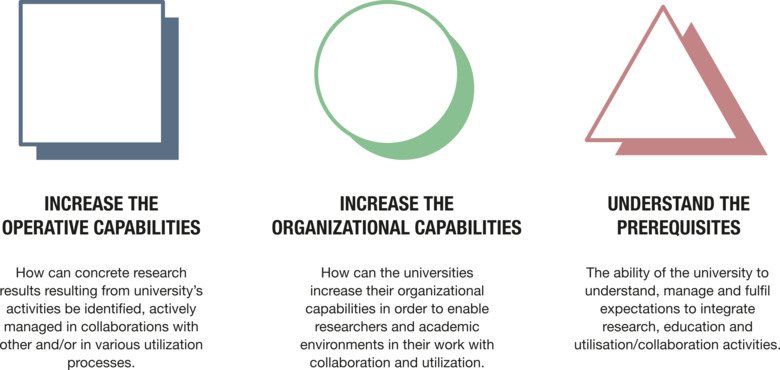Identify, protect, and utilize your research-based intellectual assets
By introducing new methods to increase the understanding and utilization of your research-based knowledge assets and intellectual property rights, KI researchers can become better at managing those assets to achieve greater societal impact.
What impact are you striving for with your research? Who can benefit from your findings? Can your research affect policy decisions? Which organizations should you collaborate with to implement your results?
University research and knowledge can be utilized, that is, come to use and create value in society, in many different ways. Based on the goals and desired societal effects that a specific research group or university strives for, utilization can happen, for example, through knowledge exchange, collaboration, licensing, commercialization, student-driven projects, or making research results readily available.
In a large project, sixteen Higher Education Institutions (HEIs) have been working together to share methods and lessons learned from testing the Knowledge Management Platform, a model that develops organizational and operational capabilities and processes to enable, support and manage the utilization of research at HEIs for societal benefit. The work is based on 25 years of research at the University of Gothenburg and other universities, as well as practical experience in research-support activities.
Overarching purpose of the project
The main purpose is to build knowledge and introduce new ways of working for researchers and HEIs to actively identify, evaluate and utilize their knowledge assets to increase collaboration and societal impact. The goal of this ongoing project is to test, develop, and implement these methods at the universities involved.
What are knowledge assets?
Knowledge assets are something that can be conceptualized and described as an object or concept, i.e., not an ability. It can be defined specifically and clearly in terms of a relevant use and function that is unique to the context or research area, i.e. not generic or standardized knowledge. It should be useful and value-adding. With the methods from the Knowledge Management Platform, the identified knowledge assets are sorted into the following categories: data, databases, observations, theoretical frameworks, technical solutions, instructions, and visualizations.

Increase organisational capability
A series of workshops have been conducted to focus on the value-chain for utilisation- from research and education to societal impact. These workshops have been conducted with the aim of highlighting the roles, responsibilities, and interface of KI’s innovation system, and to catalogue what support is available today for researchers to have an impact on society. This activity became particularly urgent with the recent initiative by the government to conduct an HEI wide inquiry into the support for researchers and students in the innovation and commercialisation process.
Participants in these workshops included KI’s leadership, representatives from various functions of the innovation system, and senior researchers.
Through the discussions with these different participants, we have found that KI offers extensive support. There is now a better understanding between these parties of the different services, activities, and competencies offered, and how the needs of the recipients are met. The support that is available can be better communicated and clarified. Building upon this foundation for the future, the first proposal for a goal of comprehensive long-term support is being developed and refined through dialogue with KI's management, researchers and students. Identified areas of development, challenges and opportunities will be addressed through continued collaborations and using common working methods.
Increase operational capability
In close collaboration with KI Innovations AB, KI has tested the Knowledge Management Platform methodology with two pilot projects in research groups from different disciplines. The purpose was to see if the methodology can be used and adapted to KI's activities, and whether the overall knowledge in the process is valuable for research groups. The process can be broken down into three main steps:
1. conduct an internal analysis to identify the research group’s knowledge assets and associated intellectual property rights.
2. conduct an external analysis to determine the interest other organisations or individuals for the identified knowledge assets and how they can be used.
3. develop a plan to disseminate, implement, license or even commercialise the knowledge assets based on defined impact goals.
The first pilot project, with a focus on supporting research-based social innovations, was conducted with Ida Goliath, RN, Associate professor, SFO-V Fellow, Division of Innovative Care Research, LIME. Her research is focused on end-of-life care, using innovative participatory approaches to capitalise on experiential knowledge from the perspective of patients, family and staff to improve communication, wellbeing and the quality of care towards the end-of-life. By using the methodology to capture their knowledge assets, the research group gained new insight and understanding of the significance of their own knowledge assets for other sectors, resulting in increased social benefit. This knowledge is also beneficial when writing grant applications.
The second pilot project was carried out together with Anna Falk, Associate Professor, Department of Neuroscience. Her research group focuses on deriving and studying cellular models of brain development in health and disease using iPS cells, neural differentiation, neural stems cells and organoids. They study human neurodevelopment disorders and compare the in vitro neural development of patient-specific cells with healthy cells. By going through the process to capture their knowledge assets, the group has gained new insights into their core activities and methods that now, together with KI Innovation AB, can be further developed for the benefit of society.
Web-based platform under development
The newly launched web-based platform imp-act.se (currently in Swedish) provides resources for researchers, operational and innovation support system personnel, and to the university management. The platform contains tools, mini-courses, case stories and examples of how others have used and implement the working methods.
References and additional reading: Center for Intellectual Property, Gothenburg University
